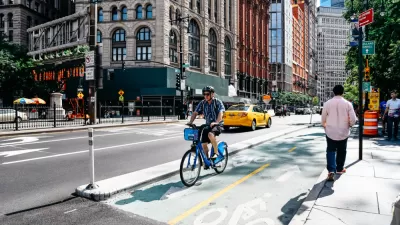Anyone who uses a bike to navigate their city knows that every ride has stretches that are much more stressful than others. A new project collects data from brainwaves to map the stress levels of bikers in New York City.
Alex Davies writes about the MindRider Map, "which is created by deploying cyclists wearing a helmet that measures their brainwaves." The resulting map provides information on "like which route would be the most relaxing, and which the most demanding of your attention."
MindRider is the work of Arlene Ducao, who developed the technology behind the idea while a graduate student at MIT.
"The setup is simple: An off-the-shelf EEG brainwave sensor made by NeuroSky is built into a standard helmet. To make the map, eight riders spent September and October riding most of Manhattan (favoring north-south thoroughfares over east-west cross streets). Every second, the EEG sensor sends, via Bluetooth, data on the rider’s level of focus. Attention level rises when the user focuses on one thing (say, a car about to swerve into the bike lane), and decreases when they’re less focused."
The article goes on to detail some of the caveats related to the data collected conducted so far—like skewed perspectives generated by a limited pool of riders and the limitations of the off-the-shelf EEG sensor. But the potential of this kind of information, and this kind of research, is also tremendous for informing planners looking to improve bike infrastructure as well as bikers planner for the least stressful route.
FULL STORY: Measuring Brainwaves to Make a New Kind of Bike Map for NYC

Alabama: Trump Terminates Settlements for Black Communities Harmed By Raw Sewage
Trump deemed the landmark civil rights agreement “illegal DEI and environmental justice policy.”

Planetizen Federal Action Tracker
A weekly monitor of how Trump’s orders and actions are impacting planners and planning in America.

The 120 Year Old Tiny Home Villages That Sheltered San Francisco’s Earthquake Refugees
More than a century ago, San Francisco mobilized to house thousands of residents displaced by the 1906 earthquake. Could their strategy offer a model for the present?

In Both Crashes and Crime, Public Transportation is Far Safer than Driving
Contrary to popular assumptions, public transportation has far lower crash and crime rates than automobile travel. For safer communities, improve and encourage transit travel.

Report: Zoning Reforms Should Complement Nashville’s Ambitious Transit Plan
Without reform, restrictive zoning codes will limit the impact of the city’s planned transit expansion and could exclude some of the residents who depend on transit the most.

Judge Orders Release of Frozen IRA, IIJA Funding
The decision is a victory for environmental groups who charged that freezing funds for critical infrastructure and disaster response programs caused “real and irreparable harm” to communities.
Urban Design for Planners 1: Software Tools
This six-course series explores essential urban design concepts using open source software and equips planners with the tools they need to participate fully in the urban design process.
Planning for Universal Design
Learn the tools for implementing Universal Design in planning regulations.
Clanton & Associates, Inc.
Jessamine County Fiscal Court
Institute for Housing and Urban Development Studies (IHS)
City of Grandview
Harvard GSD Executive Education
Toledo-Lucas County Plan Commissions
Salt Lake City
NYU Wagner Graduate School of Public Service





























